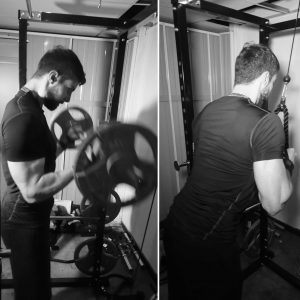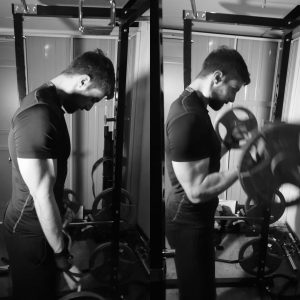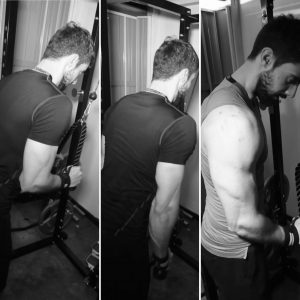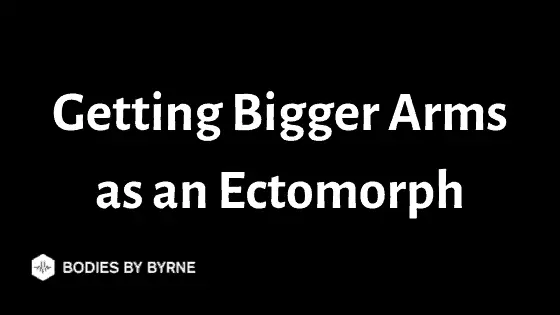How to get bigger arms as an ectomorph is a common problem, long limbs combined with relatively small muscle groups is not a combination for size.
As an ectomorph, your body type characteristics will like fall under the category of long limbs, small joints and small muscle insertion points (your muscles generally look smaller).
All of these characteristics are pretty much the worst when it comes to building muscle and a physique so you are not in the strongest starting position. As with most things in life some hard, and more importantly smart work will still reap results.
Big, well developed arms tend to be the most sought after body part when you first start working out and people will know what a bicep curl is long before they hear about stiff leg deadlifts or weighted dips.
For this reason there are thousands of articles and videos that revolve around building bigger arms, there are even countless publications from the 60’s that target arms so regardless of what you hear or read there isn’t a technique or routine that hasn’t been tried before.
If you’re reading these articles or watching the videos as an ectomorph then chances are you will see very little progress from the advice given. It’s not that the advice isn’t relevant or good, it’s that an ectomorph simply can’t do a few sets of dumbbell curls and hope to build a decent set of arms.
The strategies laid out in this article are not radical or new, just basic concepts that need to be applied for any ectomorph to see some progress in their arm development.

Anatomy of the Arms
Before getting started on workout plans and training principles it’s important to know the anatomy of the arms. Not only is understanding the anatomy crucial for exercise selection and selecting the optimal set and rep schemes but it is also the foundation of using effective form.
Effective form is different from strict form as it takes into account individual anatomy. Someone with poor mechanics for a squat looking to train quads might be better off selecting an exercise that offers a lower weight potential. Using Bulgarian split squats to target the quads for example will mean you can’t go as heavy as you could with a squat but could potentially recruit more muscle fibers resulting in more muscle growth.
Everyone will have different muscle insertion points, number of muscle fibers and a different fiber makeup in terms of fast/slow twitch fibers however there are some basic anatomy makeups of the arm that are relevant to everyone.
Triceps
A lot of focus goes on the biceps when it comes to building arms because they are the show off muscle, however when it comes to building size and working on overall arm development then your main focus should be on triceps to begin with.
This is because the triceps make up ⅔ of the entire upper arm, if you want bigger arms it makes sense to target to largest muscle group as this will have the most room for growth. The triceps are made up of three heads: the lateral head, medial head and the long head
The lateral and medial heads can be viewed on the outside of your arm (though the medial head isn’t actually seen as it is found in between the two other heads) whereas the long head is found visible on the inside portion of the upper arm. All heads have different insertion points which is important when it comes to exercise selection and this is because the long head often gets neglected in most tricep exercises.
Compound movements like close grip bench presses and dips will work all three heads to an extent however to truly target the long head you will need to select exercises that work the tricep in an overhead position like skull crushers or dumbbell overhead tricep extensions.
Biceps

The biceps, whilst smaller than the triceps in overall upper arm mass, still have plenty of potential for growth and is up there as one of the most favoured muscle groups for people to train. Much like performing similar exercises in the same movement patterns for triceps will leave some heads neglected the same is true of biceps.
The biceps are made up of two heads, the long head and the short head. The long head passes over the humerus and attaches to the top of the shoulder joint, it’s located as the outside section of the bicep. The short head as the name suggests is the shorter of the two heads and is the inside part of the bicep.
There is another muscle group that contributes to arms size and runs directly underneath the bicep from the forearm and that is the brachialis. Selecting exercises to target all three heads will again be necessary for well developed upper arms.
Forearms
An often neglected component of arm training for the majority is direct forearm work. There are arguments to say that direct forearm work is not necessary if you perform heavy back work in the form of rows, deadlift and pull-ups however in these instances the forearm muscles are working as a secondary muscle group so do not receive maximum stimulation.
The forearm is made up of three primary muscle groups that you will target through weightlifting: forearm flexors, extensors and brachioradialis.
The flexors are located on the inside (palm side) of the forearm and are responsible for extension and supination of the wrist and forearm. A simple way to target the flexors is a movement that involves curling your wrist/palms towards your body.
The extensors are located on the outside of the forearm and are responsible for flexion and pronation of the forearm. Opposite to the flexors, in order to target the extensors you need to pick movements that curl the wrist/palm away from your body.
Both of the above muscle groups are targeted with heavy rowing and pulling exercises however the involvement will vary depending on hand placement. Palms facing you will mean more supination and will target the flexors, palms facing away will mean more pronation and therefore bring the extensors into focus.
The brachioradialis is located around the elbow joint and is responsible for flexion of the forearm at the elbow. Exercises to specifically target this muscle group are hammer curls where the wrist takes a neutral grip (thumbs pointing in front of you), neutral grip pull-ups and reverse curls. These exercises also target the biceps brachialis so it’s essential that these are included in your routine.
Compound Exercises for Arm Growth
Before looking at specialised routines and exercises to target the arms you first need to make sure you are including basic compound movements in your routine. As an ectomorph these should be the bread and butter of your routine and will have immense carry over to your arm development.
Before explaining further a simple exercise example will help illustrate my point. Weighted dips will primarily target three muscle groups: chest, triceps and anterior delts, changing body position can place more or less emphasis on each muscle group however all of them will still be active to some degree.
Now you want to target your triceps and currently do a cable push down variation, this is a single joint isolation exercise so your potential for weight progression is quite low, it’s unrealistic to think you will be pressing the whole stack! With a dip however you will start with your body weight and then have the potential to add more weight through a dipping belt or holding a dumbbell between your legs.
The potential weight for a tricep cable pushdown could be 100lbs, however the potential for a weighted dip is easily 200lbs and over. Which one do you think would stimulate more muscle growth?
Whilst weight lifted is not the only factor in muscle growth, it is a significantly large component and therefore selecting exercises that offer greater potential for weight increases will also offer greater potential for muscle growth.
This is where compound movements are key to developing your arms and should be the primary focus of your routine.
Your biceps, triceps and forearms will always act as a secondary muscle in these exercises (though some can be tailored to shift the focus onto the arms and we’ll look at these later) however, even as a secondary exercise the potential for weight lifted is much greater than if you used only isolation exercises.
If you’re looking for the most effective compound movements to have carry over to your arm development then first up you want to include close grip bench presses and weighted dips. These are the biggest bang for your buck Exercises for triceps and at least one should be a staple in your routine.
For biceps you want to be looking at heavy rows and weighted pull-ups but particularly with your arms in supination (palms facing you) or neutral. These will activate the biceps though they will still be acting as a secondary muscle. Finally for forearms you want to do heavy pulling movements and deadlifts without the assistance of straps.
Many people, myself included, will use straps to isolate the back more and take your arms out of the movement to an extent. This is a good strategy for building a strong back however when it comes to arm development you want as much carry over from other exercises as possible. Therefore restrict the use of straps and build up your grip strength to have maximum carry over to your arm development.
Best Exercises for Bigger Arms
Now that compound movements have been covered you will want to include some isolation exercises for each muscle group to really bring up your arms. These do not need to be an excessive amount and a few sets for each movement will more than cover your needs.
As long as you work all heads and rep ranges of a muscle group you will be guaranteed progress until you become more advanced in your training. The below are some of the most effective exercises for each muscle group and while it’s not an exhaustive list you can substitute some exercises to suit your preference (using a cable instead of a dumbbell for example).
Best Tricep Exercises for Bigger Arms
When we look back at the anatomy of the triceps there are three heads that need to be targeted, the lateral head, medial head and long head. The bulk of your tricep work should come from heavy compound lifts as they are active during all pressing movements, especially if you use a narrow/closer grip for your presses.
They won’t however cover all three heads so make sure to include the following in your routine.
*the following are movements and are therefore open to individual preference and anatomy constraints. It doesn’t matter if you use a cable, dumbbell, barbell or other as long as you target the movement.
Overhead Tricep Press
This will target the often neglected long head of the tricep which is primarily active during shoulder flexion (arms raised). The more emphasis on an overhead position the greater the stretch to the long head and ultimately greater tricep activation.
This movement can be performed standing, seated or even lying in the form of a skull crusher. If you’ve ever done a pullover movement to target the lats before then you may have felt some soreness in your tricep afterwards and this is because of the stretch to the long head of the tricep when your arms are extended overhead.
Therefore to fully utilise this movement in the form of a skull crusher you can lower the weight as normal to your forehead but then to extend it further, lower the weight behind your head to put the long head under further stretch.
Cable Tricep Pressdown

The best attachment for this would be a long rope attachment or if not available then it’s best to do this one arm at a time with a D handle. The reason these should be your first choice is because they will allow you to get your tricep into a fully shortened position which will allow for optimal contraction.
A V-attachment or standard rope will not allow the range of motion needed to get the tricep fully shortened which should be your arms extending behind your body rather than finishing by your sides.
This is a great movement for the tricep as the cable will keep constant tension on the triceps throughout the movement. With a single arm variant you can also position your body so that the cable lines up with joint during the movement (when the arm is extended and straight the cable should be in a straight line down the bicep and forearm, if the cable covers the forearm but not the bicep then your anterior deltoid will also be active).
Best Bicep Exercises for Bigger Arms
To target the bicep fully you will need to do a variety of movements with your humerus in a range of different positions in relation to your torso. A barbell curl and alternating dumbbell curl will both work the same movement pattern and whilst offering a slightly different stimulus it won’t offer maximum hypertrophy for the biceps.
Instead a variety of hand positions and humerus position in relation to the torso is what will offer the greatest growth potential.
Whilst a standard bicep curl will work for a lot of people the following exercises are geared specifically for working all heads of the bicep as well as all ranges (fully shortened/contracted and lengthened/extended). A standard curl is good for working the mid range of the bicep strength curve however when you consider that at the bottom of the movement with your arms by your side there is minimal to zero tension on the bicep. Then at the top of the movement past a certain point as the dumbbell approaches the shoulder you will also lose tension.
The key to most effective training programs is to try and effectively work the muscle through all its possible ranges, you should essentially be selecting a few exercises to target all heads of the muscle group as well as working them through all ranges and getting progressively stronger in the movement. The bicep is the best muscle group to demonstrate this and could be where many ectomorphs are going wrong in their arm routines.
Dumbbell Hammer Curl
The dumbbell hammer curl is a more effective version of a standard dumbbell curl in my opinion for two reasons. The first is that it not only targets the bicep but also the brachialis which was mentioned earlier, this is due to the neutral grip of the dumbbell causing flexion of the forearm and activating the brachialis.
Developing the brachialis alongside your bicep will further develop overall arm size and musculature which makes this a more worthwhile movement in my opinion. The second reason I prefer this exercise over a standard dumbbell curl is because you can lift more weight due to the additional muscle groups of the forearm being active.
Having a movement that allows to to progress with more weight using the same form will always tend to reap better results. This movement will also work the mid range of the bicep so it’s best to use first when you’re fresh and strongest.
This movement also has the additional benefit of placing the long head of the bicep in a more stretched position than when your palms are in supination as your elbow and upper arm will naturally be position in a further back position. To test this, drop your hands by your side with your hands in a neutral position (thumbs pointing forwards), next turn your hands outward so that your palm is now facing forwards and pay attention to your elbow joint as you do this movement.
Unless you have a high level of flexibility you will notice that your arm will move slightly in front or your body to accommodate this position meaning your bicep will so less work in the lengthened position. It’s only a minor change however it can have a significant impact on the muscle worked and number of muscle fibres recruited.
Seated Preacher Curl
This movement will place emphasis the short head of the bicep and will work the fully shortened, contracted position or the bicep. As the long head of the bicep crosses at the shoulder joint then the further your elbows are raised in relation to your head the more the short head will need to work.
A curl with elbows behind your head will see the bicep in its most shortened position however you don’t have anything to brace your body against to maximise tension. A preacher curl allows you to lock your body into the bench and ensure the elbow joint and bicep are the only things that execute the movement so a preacher curl is my preference over a fully shortened position.
Incline Dumbbell Curl
An incline dumbbell curl will place the long head of the biceps in a more stretched position than a standard seated or standing dumbbell curl and is therefore excellent for working the end range motion of a curl.
Once you go past 90 degrees during this curl you will see a significant loss of tension as gravity takes over, therefore to make this exercise the most effective I’d recommend using a cable to keep constant tension whilst emphasising the stretched position.
Reverse Curl
This will work the brachialis and brachioradialis in addition to the bicep so should be placed last in your routine once your biceps are already slightly fatigued. Depending on wrist flexibility it’d be best to start this movement using an EZ bar so that your wrist position can be slightly angled to reduce strain.
To get the most out of this exercises it’s best to target the slow twitch fibres and focus on slow eccentrics. Your tempo should therefore be 1 second to curl the weight, a 1 second squeeze at the top, 3-4 seconds lowering the weight and no pause at the bottom. The extended eccentrics are important because the brachioradialis is primarily made up of slow twitch muscle fibres so will take longer to fatigue.
Best Forearm Exercises for Bigger Arms
With the forearms you are much more restricted with the selection of exercises to work the forearm muscles. This is because the wrist joint can either go through flexion or extension so rather than trying to get fancy with exercise selection it’s best to pick an exercise for each movement and get progressively stronger with it (this should also be the goal for most exercises really).
There are other movements that will work the forearms like loaded carries or heavy pulls targeting the back however these are working the forearm as a secondary muscle group so will not produce the maximum hypertrophic effects. The following are two basic exercises that will solely target the forearm flexor and extensor muscles.
Barbell Wrist Curl
This movement will target the forearm flexors and is to be performed with your wrist in supination (palms facing upwards). Rest your forearms on a bench so that your hands hang over the edge, you want to minimise stress on the wrist as much as possible so keep your wrist as close to the edge of the bench as possible whilst still allowing your hand to move freely up and down.
To perform this movement effectively you want to let the barbell roll to the tips of your fingers on the eccentric portion and then to a fully grasped position on the concentric. The reason for this is to allow an extra stretch to the extensors during the eccentric portion of the movement however you will need to keep in mind that this will be difficult to master at first and you will therefore need to start with a lighter weight to get used to it.
Barbell Reverse Wrist Curl
Following the exact same set up and movement pattern as a regular wrist curl you are only going to change your hand position for this exercise so palms will be facing downwards to target the forearm extensors. Again you’ll want to let this roll down your fingertips for maximum stretch on the eccentrics and the focus should be on controlling the weight rather than ego lifting.
The forearms already handle heavy loads which will target the fast twitch fibres more, so again slow eccentrics are the way to go with this exercise.
Example Arm Program
The following is an arm specific hypertrophy program, it’s worth noting that adding a few of these exercises to an already existing program and getting progressively stronger in them will still reap rewards in terms of arm growth. The following program would need a reduction in volume for your other training days to ensure you are getting adequate recovery time.
Workout A
Close Grip Incline Barbell Press – 5 x 5
Weighted Neutral Grip Pull ups – 5 x 5
Cable Rope Tricep Pushdown – 3 x 12
Cable Rope Overhead Tricep Pushdown – 3 x 12
Incline Dumbbell Curl – 3 x 8
Seated Dumbbell Preacher Curl – 3 x 8
EZ Bar Reverse Curl – 4 x 12
Barbell Wrist Curl – 3 x 15
Workout B
Weighted Dips – 3 x 8
Dumbbell Hammer Curl – 3 x 12
Single Arm Cable Tricep Pushdown – 3 x 15
Barbell Preacher Curl – 3 x 8
Lying Dumbbell Tricep Extension – 3 x 12
Barbell Reverse Wrist Curl – 3 x 15
What Next
If you are looking to make changes to your physique by either losing body fat, building muscle or looking to maintain a lean physique then sign up to my weekly newsletter below. Each week I send out actionable tips to help you lose that extra 1lb of fat or build that extra 0.5lb of muscle mass on a weekly basis.
If you sign up now you’ll also receive my 28 day body recomp program completely Free. This ebook will be sent straight to your inbox and will provide an intense 28 day program aimed at helping you lose up to 8lbs of body fat whilst also building 2lb-4lb of lean muscle mass in just 4 weeks.
Don’t worry if you’re not ready for an intense program just yet, my weekly newsletter will give smaller tips that when implemented daily, will stack up over time and see you transform your body with seemingly minimal effort!
Also check out:
How to get big as an ectomorph
Full ectomorph guide
